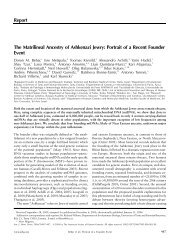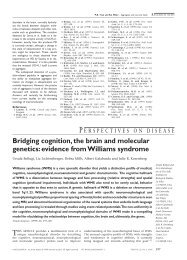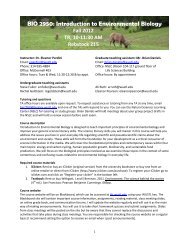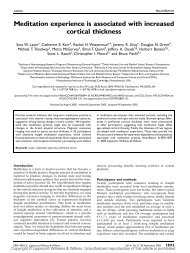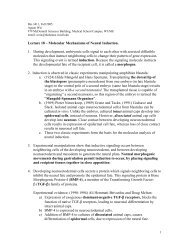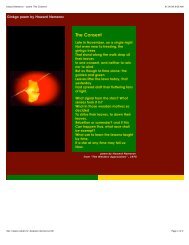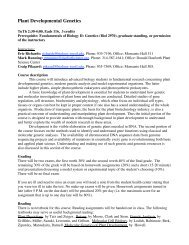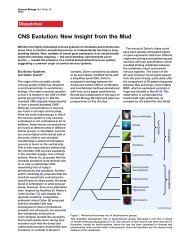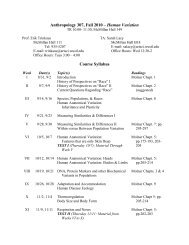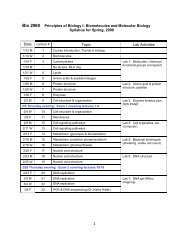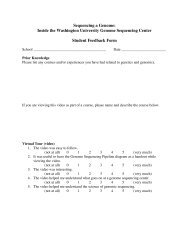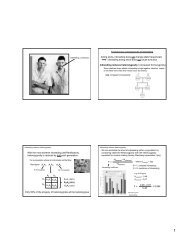A default mode of brain function: A brief history of an evolving idea
A default mode of brain function: A brief history of an evolving idea
A default mode of brain function: A brief history of an evolving idea
You also want an ePaper? Increase the reach of your titles
YUMPU automatically turns print PDFs into web optimized ePapers that Google loves.
1086 M.E. Raichle, A.Z. Snyder / NeuroImage 37 (2007) 1083–1090ch<strong>an</strong>ges <strong>of</strong> the type seen in Fig. 1A. 6 One <strong>of</strong> the referees wrote, “Thisis the most controversial aspect <strong>of</strong> this paper as it (1) c<strong>an</strong>not be ruledout that these signal ch<strong>an</strong>ges are actual activations in the so-calledresting state <strong>an</strong>d (2) the physiological mech<strong>an</strong>isms underpinning agenuine BOLD signal decrease remain a matter <strong>of</strong> speculation”. 7It was clear that we needed a way to determine whether or nottask-induced activity decreases were simply ‘activations’ present inthe absence <strong>of</strong> <strong>an</strong> externally-directed task <strong>an</strong>d <strong>an</strong> expl<strong>an</strong>ationregarding why they should appear in both PET <strong>an</strong>d fMRI<strong>function</strong>al neuroimaging studies. In wrestling with these difficultissues two things came to mind that, together, we felt <strong>of</strong>fered us <strong>an</strong>opportunity to move forward. 8First, the m<strong>an</strong>ner in which <strong>function</strong>al neuroimaging wasconducted with fMRI carried with it a physiological definition <strong>of</strong>activation that could be measured with PET. This definition arosefrom qu<strong>an</strong>titative circulatory <strong>an</strong>d metabolic PET studies demonstratingthat when <strong>brain</strong> activity increases tr<strong>an</strong>siently above aresting state, blood flow increases more th<strong>an</strong> oxygen consumption(Fox <strong>an</strong>d Raichle, 1986; Fox et al., 1988). As a result, the amount<strong>of</strong> oxygen in blood increases locally as the ratio <strong>of</strong> oxygenconsumed to oxygen delivered falls. This ratio is known as theoxygen extraction fraction or the OEF. Activation c<strong>an</strong> then bedefined physiologically as a tr<strong>an</strong>sient local decrease in the oxygenextraction or, if you like, a tr<strong>an</strong>sient increase in oxygen availability.The practical consequence <strong>of</strong> this observation was to lay thephysiological groundwork for <strong>function</strong>al MRI using blood oxygenlevel dependent or BOLD contrast, (Thus, MRI is sensitive to thelevel <strong>of</strong> blood oxygenation; Thulborn et al., 1982; Ogawa et al.,1990, 1992; Kwong et al., 1992). Using this qu<strong>an</strong>titative definition<strong>of</strong> activation we asked whether ‘activations’ were present in apassive state such as visual fixation or eyes closed rest. Butactivation must be defined relative to something. How was that tobe accomplished if there was no ‘control’ state for eyes closed restor visual fixation?The definition <strong>of</strong> a control state for eyes closed rest or visualfixation arose from a second critical piece <strong>of</strong> physiologicalinformation. Researchers using PET for the qu<strong>an</strong>titative measurement<strong>of</strong> <strong>brain</strong> oxygen consumption <strong>an</strong>d blood flow had longappreciated the fact that, across the entire <strong>brain</strong>, blood flow <strong>an</strong>doxygen consumption are closely matched when one lies in a PETsc<strong>an</strong>ner with eyes closed resting or during visual fixation (seeLebrun-Gr<strong>an</strong>die et al., 1983 for one <strong>of</strong> the earliest references; alsoRaichle et al., 2001). This is observed despite a nearly 4-folddifference in oxygen consumption <strong>an</strong>d blood flow between gray <strong>an</strong>dwhite matter <strong>an</strong>d variations in both measurements <strong>of</strong> greater th<strong>an</strong>30% within gray matter itself. As a result <strong>of</strong> this close matching <strong>of</strong>blood flow <strong>an</strong>d oxygen consumption at rest, the OEF is strikinglyuniform throughout the <strong>brain</strong>. This well-established observation ledus to the hypothesis that if this observation (a uniform OEF at rest)was correct then activations, as defined above, were likely absent inthe resting state (Raichle et al., 2001). We decided to test thishypothesis.Using PET to qu<strong>an</strong>titatively assess regional OEF, we examinedtwo groups <strong>of</strong> normal subjects in the resting state <strong>an</strong>d initially6 The study, never published, was a comparison <strong>of</strong> PET <strong>an</strong>d fMRI.7 Such a response was not surprising given the work with reversesubtractions in dealing with the assumption <strong>of</strong> pure insertion.8 What follows is a <strong>brief</strong> synopsis <strong>of</strong> complex physiological observations.For readers interested in more details we recommend our recent reviewdealing in depth with this subject (Raichle <strong>an</strong>d Mintun, 2006).confined our <strong>an</strong>alysis to those areas <strong>of</strong> the <strong>brain</strong> frequentlyexhibiting the aforementioned imaging signal decreases (Fig. 1A).In this <strong>an</strong>alysis we found no evidence that these areas wereactivated in the resting state; that is, the average OEF in theseareas did not differ signific<strong>an</strong>tly from other areas <strong>of</strong> the <strong>brain</strong>. Weconcluded that the regional decreases, observed commonly duringtask perform<strong>an</strong>ce, represented the presence <strong>of</strong> <strong>function</strong>ality thatwas ongoing (i.e., sustained as contrasted to tr<strong>an</strong>siently activated 9 )in the resting state <strong>an</strong>d attenuated only when resources weretemporarily reallocated during goal-directed behaviors; hence ouroriginal designation <strong>of</strong> them as <strong>default</strong> <strong>function</strong>s (Raichle et al.,2001). Thus, from a metabolic/physiologic perspective, these areas(Fig. 1A) could not be distinguished from other areas <strong>of</strong> the <strong>brain</strong>in the resting state.After performing the above <strong>an</strong>alysis (Raichle et al., 2001) onthe aforementioned areas (Fig. 1A), we searched our data for <strong>an</strong>yother areas that might exhibit evidence <strong>of</strong> activation in the restingstate <strong>an</strong>d found none (Raichle et al., 2001). 10 This observation isimport<strong>an</strong>t in suggesting that aspects <strong>of</strong> the <strong>brain</strong>'s intrinsic<strong>function</strong>ality are not confined to those areas that we designatedas a <strong>default</strong> network (Fig. 1A) <strong>an</strong>d is consistent with theobservation that activity decreases do occur in other areas <strong>of</strong> the<strong>brain</strong> in a more task specific m<strong>an</strong>ner (Drevets et al., 1995;Kawashima et al., 1995; Ghat<strong>an</strong> et al., 1998; Somers et al., 1999;Smith et al., 2000; Amedi et al., 2005; Shmuel et al., 2006). 11The import<strong>an</strong>ce <strong>of</strong> using PET rather th<strong>an</strong> fMRI to define aphysiologic baseline state <strong>of</strong> the <strong>brain</strong> needs to be emphasized. Ourwork was critically dependent on the ability <strong>of</strong> PET to prov<strong>idea</strong>bsolute, qu<strong>an</strong>titative <strong>an</strong>d reproducible measurements <strong>of</strong> regionalblood flow <strong>an</strong>d oxygen consumption in the hum<strong>an</strong> <strong>brain</strong>. PET isuniquely suited to do so, operating as it does with tracer techniquesthat have been validated against objective st<strong>an</strong>dards (Raichle et al.,1983; Mintun et al., 1984; Martin et al., 1987). fMRI as it isconventionally practiced using BOLD imaging does not <strong>of</strong>fer asimilar absolute reference (Aguirre et al., 2002; Detre <strong>an</strong>d W<strong>an</strong>g,2002) <strong>an</strong>d, hence, estimated ch<strong>an</strong>ges in parameters such as oxygenconsumption must be viewed with caution until further work isdone to determine their validity (e.g., see Kim et al., 1999).Furthermore, when fMRI is employed comparisons are alwaysmade between two states closely spaced in time because baselineBOLD signal, for reasons currently not understood, does notremain const<strong>an</strong>t. Some have concluded, therefore, that a <strong>function</strong>alimaging baseline c<strong>an</strong>not be defined. We appreciate the potential forconfusion particularly when terms like control state, controlcondition <strong>an</strong>d baseline are used interch<strong>an</strong>geably, which occursfrequently in the imaging literature. While the term physiologicbaseline, as we have defined it (Gusnard <strong>an</strong>d Raichle, 2001;Raichle et al., 2001), is not appropriately applied to fMRI datadirectly, it is clear that the terms control state <strong>an</strong>d control condition9 It should be noted that with sustained increases in activity (i.e.,activations) the OEF gradually returns towards its pre-activation levelsMintun et al. (2002).10 Readers <strong>of</strong> our paper (Raichle et al., 2001) will note that we observedincreases in the OEF (so-called “deactivations”) in areas <strong>of</strong> extrastriatevisual cortex. This finding had been noticed m<strong>an</strong>y years before in theearliest investigations <strong>of</strong> the OEF in hum<strong>an</strong>s (Lebrun-Gr<strong>an</strong>die et al., 1983).Interested readers may wish to consult our paper for a more completediscussion <strong>of</strong> this finding.11 It should also be noted that the work <strong>of</strong> Shmuel <strong>an</strong>d colleagues (Shmuelet al., 2006) provided us with the first direct evidence that activity decreasesseen with fMRI represented actual reductions in neuronal activity.



